Tel: 01474 876800 • Client Portal
- Who We Are
- What We Do
- Build
- Carpentry
- Building Works
- Commercial Flooring
- Commercial Glazing
- Commercial Locksmith
- Commercial Painting & Decorating
- Commercial Plastering
- Commercial Plumbing
- Commercial Refurbishment
- Commercial Roofing
- Design & Construction
- Electrical Installation
- Hard & Soft Landscaping
- Mechanical & Electrical
- Office Builders
- Office Fit Outs
- Office Heating
- Office Partitioning
- Office Relocation
- Site Management
- Maintain
- 24 Hour Helpdesk
- Access Control
- Air Conditioner Repair
- Air Conditioning Servicing
- Commercial Boiler Servicing
- Commercial Electricians
- Commercial Ground Maintenance
- Commercial Pest Control
- Commercial Property Maintenance
- Drain Unblocking
- Emergency Callouts
- Emergency Light Testing
- Facilities Management
- Fire Alarm Testing
- Fire Extinguisher Testing
- Fire Sprinkler Testing
- Fixed Wire Testing
- Handyman Service
- Lift Servicing
- Office Health & Safety
- PAT Testing
- Planned Preventative Maintenance
- Reactive Maintenance
- Roof Maintenance
- TMV Maintenance
- Water Hygiene
- Clean
- Build
- How We Do It
- Why Use Us
- Contact
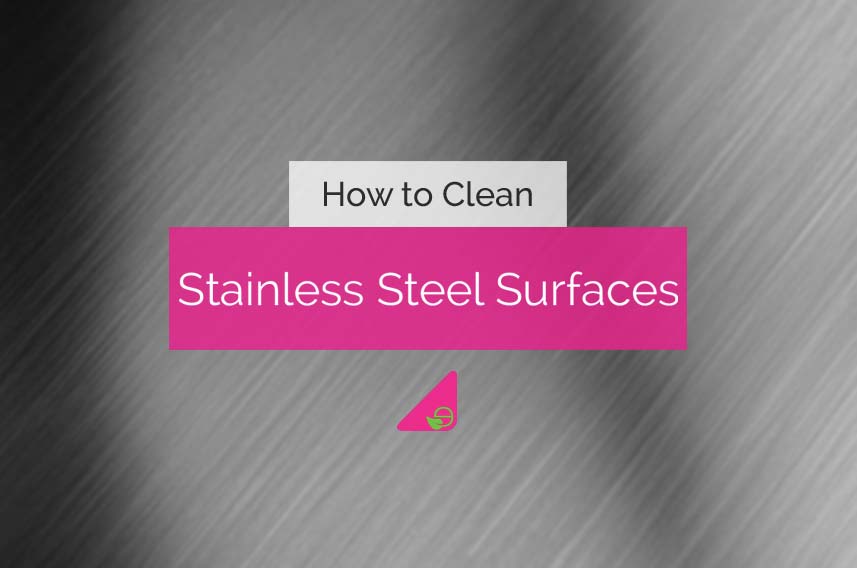
How to Clean Stainless Steel Surfaces
Stainless steel surfaces are common in offices, commercial kitchens, laboratories, and workshops because they look modern and last a long time.
They resist rust and can even last over a century with proper care.
Stainless steel’s smooth, non-porous finish also meets strict hygiene standards.
However, it can easily show fingerprints, water spots and smears, so it does need regular cleaning to stay shiny and sanitary.
So how should you clean stainless steel surfaces?
This article explains practical cleaning steps, safety tips and best practices for anyone who maintains stainless steel in a workplace.
Table of Contents
How to Clean Stainless Steel Surfaces
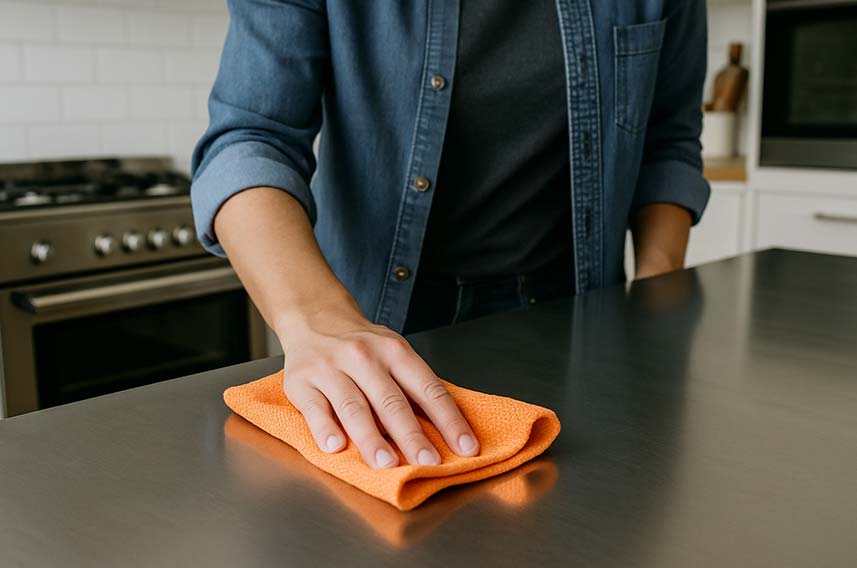
Gather the right supplies before you start.
At a minimum, you will need a clean soft cloth or microfiber cloth, warm water, and a gentle cleaner.
A mild detergent or dish soap works well for routine cleaning.
You may also want gloves to protect your hands and to keep oils off the surface.
Do not grab steel wool or rough scrubbers – use only non-abrasive pads or brushes.
Microfiber cloths and non-scratch sponges are ideal because they won’t scratch the metal.
If the stainless steel is greasy or very dirty, consider using a commercial stainless steel cleaner or a weak vinegar solution (vinegar is mildly acidic but safe for stainless when rinsed off).
Keep the cleaner mild: avoid bleach or any product with chlorine or chloride, which can pit the steel.
Steps to Follow
When you begin cleaning, follow these key steps carefully:
Remove Loose Debris
Wipe the surface with a dry microfiber cloth to brush away dust, dirt and crumbs.
This prevents grinding grit into the metal when you wash it.
Wash With Mild Soap and Water
Mix warm water with a small amount of neutral detergent (like washing-up liquid).
Wet a cloth or sponge in the solution and gently scrub the surface.
Always wipe along the grain of the metal, not against it.
The grain is the pattern in the metal’s finish, and moving with the grain avoids scratches and leaves an even polish.
For a stainless steel bench or fridge door, you might spray your cleaner on the cloth (or directly on the surface) and wipe with even strokes in one direction.
Rinse Thoroughly
After soaping, wipe the surface with a clean damp cloth to remove any detergent residue.
Soap or cleaning agents left on the metal can cause streaks or dull spots.
Use plain water on the cloth and go over the area again to rinse off all cleaner.
Dry and Buff
Immediately dry the surface with a soft towel or dry cloth.
Leaving water to evaporate will leave mineral spots (especially in areas with hard water).
Wipe until the metal feels dry.
Then buff with a dry part of the cloth – this means rubbing with a clean, dry microfiber in the direction of the grain.
Buffing helps bring out the shine and remove any remaining streaks.
Handling Tough Stains and Grease
If routine washing doesn’t remove all stains, you’ll need to clean more deeply:
Scrub Gently
For built-up grime (for example, a sink or heavily used bench), use a soft nylon cleaning brush or pad.
Do not use steel wool or harsh brushes.
Using a nylon brush or non-abrasive pad with soapy water can remove stuck-on food or grease.
Use a Paste Cleaner
For very stubborn spots (burnt-on food, rust stains, or hard water scale), a mild abrasive cleaner like a baking soda paste or a product called Bar Keepers Friend can help.
Sprinkle a little baking soda on a damp cloth or directly on the spot, then rub gently.
These cleaners are non-abrasive when used correctly, meaning they will not damage the chromium oxide layer on the steel.
After scrubbing, rinse away all paste or cleaner completely with water.
Disinfect If Needed
In kitchens or labs you may want to sanitize surfaces.
A 70% isopropyl alcohol wipe is safe for stainless steel and evaporates quickly.
Spray or wipe with alcohol, then rinse with water and dry.
What to Avoid When Cleaning Stainless Steel Surfaces
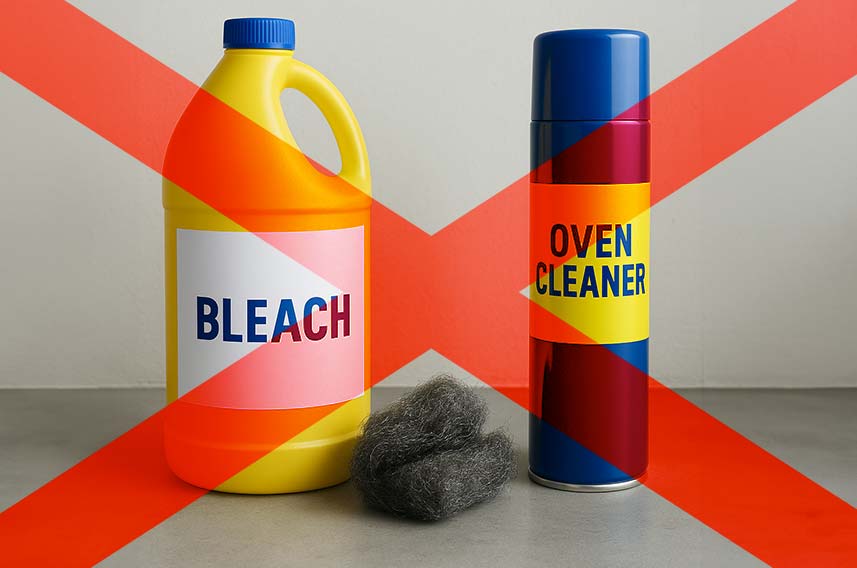
When cleaning stainless steel, certain products and practices will cause damage.
Bleach or Chlorine Cleaners
Do not use bleach, chlorine-based bathroom cleaner, or anything with chloride salts.
These chemicals attack stainless steel’s protective layer and can cause pitting and corrosion.
For example, household bleach or disinfectant with sodium hypochlorite can dull or rust the surface if not rinsed away quickly.
If any chlorine cleaner does touch the metal, rinse it off immediately with water.
Abrasive Pads and Steel Wool
Never scrub stainless steel with steel wool, wire brushes or rough scouring pads.
These will scratch the surface deeply.
Even tiny metal particles from steel wool can embed and later rust, leaving spots.
Similarly, coarse Scotch-Brite pads (green pads) are too harsh.
Always use a soft sponge, soft nylon brush, or a green non-scratch scrubber.
Oven Cleaners and Strong Acids
Oven cleaner, which often contains caustic chemicals, will etch stainless steel.
Harsh acids like hydrofluoric acid or hydrochloric acid (found in some mould and mildew cleaners) will also damage it.
These are never needed for routine cleaning.
Dishwasher Detergent or Citrus
Some dishwashing liquids contain citrus oils or bleach – avoid them if possible.
Even if they say ‘dish-safe’, lemon or orange oils and added chlorine can harm the finish over time.
Stick to plain mild detergents.
Wrong Direction of Scrubbing
Always move along the polish lines, not against them.
Scrubbing against the grain can leave fine scratches.
Letting Dirty Items Sit
Don’t leave metal cans, steel cookware, or wet cloths on a stainless sink for long.
They can leave rings or discolouration.
Also avoid leaving salt or acidic foods on hot stainless, as this can cause staining (this is especially important for cookware).
Ignoring the Manual
If your stainless steel item (appliance, equipment or finish) came with care instructions, follow those guidelines.
Manufacturers often note which cleaners to use or avoid.
No one knows your product better than the maker.
How to Keep Stainless Steel Surfaces Clean for Longer
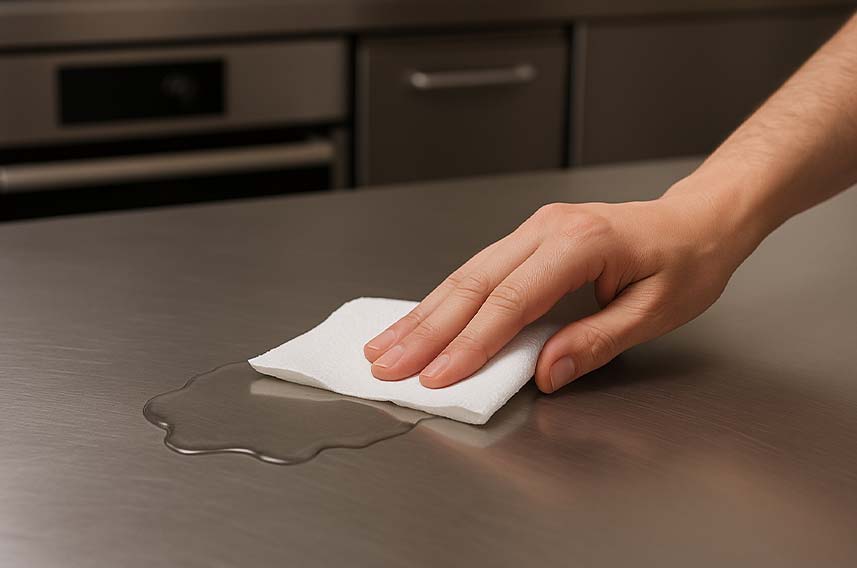
Once you’ve cleaned stainless steel, good habits will keep it looking better longer.
Here are some tips:
Wipe up Spills Immediately
Any spill of coffee, oil, acidic cleaners or chemicals should be wiped off at once.
Quick cleanup prevents stains and corrosion.
In fact, wiping away food or liquids as they occur is one of the easiest ways to keep the surface pristine.
Dry After Every Wash
Never leave stainless steel surfaces wet.
After washing or disinfecting, dry it thoroughly with a clean towel.
Moisture left on the surface causes water spots (the white chalky hard-water marks).
Removing water quickly ensures the protective chromium oxide layer can regenerate and keeps the steel shiny.
Regular Light Cleaning
Instead of waiting for visible dirt, wipe down high-touch surfaces daily.
A quick go-over with a microfiber cloth removes fingerprints and light smudges.
The simpler your routine, the less heavy scrubbing will be needed later.
Use Protective Polishes
Every so often, apply a thin coat of stainless steel polish or a light oil (mineral or olive) and wipe it off.
This builds a thin protective layer that repels water and fingerprints.
Avoid Cross-contamination
In kitchens or labs, use separate cloths or gloves for stainless steel and other surfaces.
Do not mix cleaners (for example, cleaners used on floors should not be used on benches).
This prevents unwanted chemicals from touching the steel.
Benefits of Using Stainless Steel Surfaces
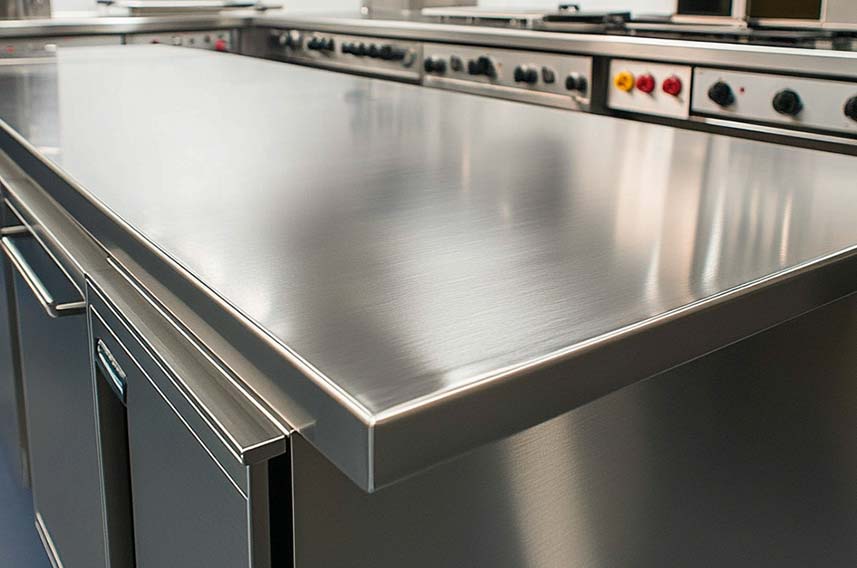
Stainless steel is widely used because of its many advantages.
Key benefits include:
Hygienic and Easy to Clean
Stainless steel is non-porous, so it resists harboring bacteria and germs.
It meets strict hygiene standards required in kitchens and labs.
Spills and soils on stainless steel can be cleaned quickly with soap and water, leaving no place for microbes to hide.
Corrosion Resistance
The ‘stainless’ in stainless steel comes from its high chromium content, which forms an invisible protective oxide layer on the surface.
This layer protects the metal from rusting.
In normal conditions, stainless steel will not rust easily, even in damp environments.
Durability and Strength
Stainless steel withstands heavy use, impact and high temperatures.
It can take cuts and impacts better than softer materials, and it tolerates heat (hot pots and pans or industrial equipment heat) without warping.
A well-maintained stainless steel installation can last for decades or even outlive the building.
Aesthetics
Stainless steel has a clean, modern look that fits many environments.
Its smooth surface and shiny finish give a sense of high quality and professionalism.
It is also available in various finishes (brushed, satin, polished) to match different styles.
Sustainability
Stainless steel is highly recyclable.
Most stainless installations contain a high percentage of recycled steel, and at end of life the material can be melted down and reused without loss of quality.
Its long life means less frequent replacement compared to cheaper materials.
Heat and Fire Resistance
Unlike wood or plastic, stainless steel will not burn or degrade in fire, making it safer in a workplace.
It holds up under flames or hot equipment, a useful property in kitchens and labs.
Downsides to Using Stainless Steel Surfaces
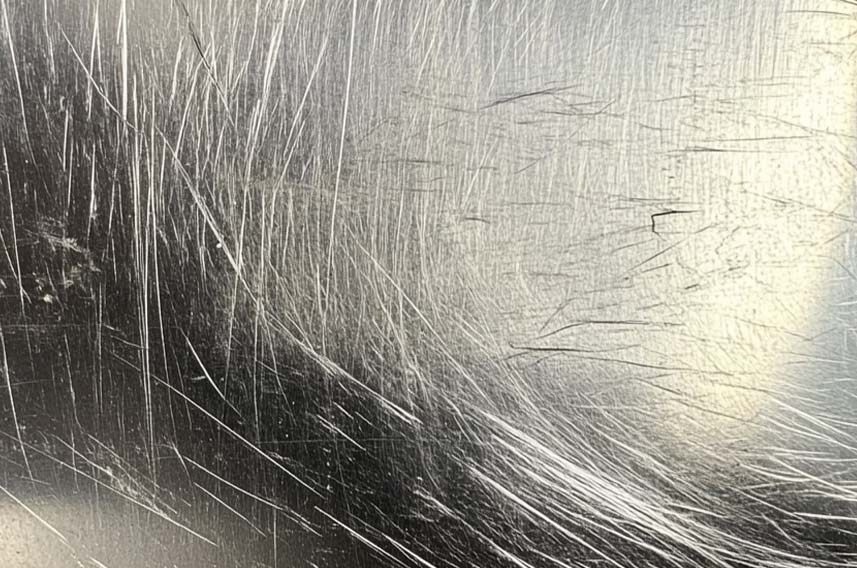
Despite its many positives, stainless steel does have a few drawbacks:
Visible Fingerprints and Smudges
Because of its reflective finish, stainless steel shows every fingerprint, smudge and splash of water.
This means it often needs more frequent wiping than some other surfaces.
If a polished, gleaming look is needed at all times, you’ll have to clean more often.
Scratches and Abrasions
Though durable, stainless steel can be scratched by sharp objects or rough cleaning.
Scratches are permanent (though minor ones may blend into a brushed finish).
Over time a very worn stainless surface may appear dull from many fine scratches.
For example, dragging heavy cookware across a stainless worktop can leave lines.
Noisy
Stainless steel surfaces can be quite loud when struck by hard objects (think of the clatter of pots on a steel countertop).
In a quiet office or lab, the echoing sound of metal can be a nuisance.
Cost
Stainless steel is more expensive up-front than materials like laminate or basic plastics.
While it often pays off with longevity, the initial investment for big stainless installations can be high.
Conducts Heat and Cold
Metal heats up or cools down quickly, so stainless steel countertops can feel very cold or very hot to touch depending on the environment.
While this property makes it good in cooking (it tolerates heat), it can be uncomfortable in a chilly office.
Conclusion
You should now have an understanding of how to clean stainless steel surfaces.
Stainless steel surfaces provide a clean, durable workspace, but only if they are looked after.
By following the steps above, you can keep steel benches, sinks, appliances and machinery looking bright and hygienic.
Key points are to use only soft cloths and mild cleaners, always work with the grain, and dry the metal promptly after washing.
Avoid harsh chemicals like bleach or rough scourers, which can damage the steel.
With regular gentle cleaning and occasional polishing, stainless steel can retain its shine for years. In the end, the extra care is worth the effort.
A well-maintained stainless steel surface not only looks professional, it will continue to perform safely and last a lifetime in your office, kitchen or industrial setting.
For more information, or help with your corporate cleaning needs, get in contact with us here at ECMS.
Request a Callback
Recent Posts
- How to Clean Stainless Steel Surfaces 01th Aug 2025
- 10 Common Saniflo Toilet Troubleshooting Solutions 01th Jul 2025
- Importance of Personal Hygiene at Work 01th Jun 2025
- How to Clean a Toilet Brush 01th May 2025
- How to Clean Painted Walls 01th Apr 2025
- How to Get Oil Stains Out of Carpet 01th Mar 2025
- How to Clean a Fridge and Remove Bad Smells 01th Feb 2025
- How to Get Coffee Stains Out of a Carpet 01th Jan 2025
- How to Clean Gutters Correctly 01th Dec 2024
- What is PAT Testing? 01th Nov 2024

